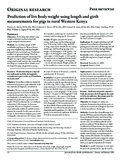| dc.contributor.author | Ogara, W O | |
| dc.contributor.author | Schelling, E | |
| dc.contributor.author | Arimi, S M | |
| dc.contributor.author | Dewey, C E | |
| dc.contributor.author | Mutua, F K | |
| dc.date.accessioned | 2013-06-13T09:54:43Z | |
| dc.date.available | 2013-06-13T09:54:43Z | |
| dc.date.issued | 2011-01-15 | |
| dc.identifier.citation | Mutua, F.K., Dewey, C.E., Arimi, S.M., Schelling, E. and Ogara, W.O. 2011. Prediction of live body weight using length and girth measurements for pigs in rural Western Kenya. Journal of Swine Health and Production 19(1):26–33. | en |
| dc.identifier.uri | http://hdl.handle.net/11295/32927 | |
| dc.identifier.uri | http://erepository.uonbi.ac.ke:8080/xmlui/handle/123456789/32927 | |
| dc.description.abstract | To develop and validate a pig weight-estimation method using body length and girth measurements. Methods: In a random sample of 288 smallholder pig farms in Western Kenya, pigs were weighed (kg) and their lengths and girths were measured (cm). Prediction models were generated using 75% of the data and validated using the remaining 25%. Weight was regressed on length and girth using mixed model analysis after controlling for village as a random effect. Models were developed for pigs categorized as young (? 5 months), market age (5.1 months to 9.9 months), and breeding age (? 10 months). Results: Weights (mean ± SD) of the young, market-age, and breeding-age pigs were 12 ± 6.1 kg, 30 ± 11.4 kg, and 42 ± 17.0 kg, respectively. Models for the young, market-age, and breeding-age pigs were weight = 0.18 (length) + 0.36 (girth) – 16, weight = 0.39 (length) + 0.64 (girth) – 48, and weight = 0.36 (length) + 1.02 (girth) – 74, respectively. A single prediction model for weight = 0.25 (length) + 0.56 (girth) – 32 was also developed. Weight predicted by the models was a more accurate estimate than that provided by the farmers (P < .05). Length and girth explained 88% to 91% of the total variation in weight. Implications: The weight-estimation tool will empower Kenyan farmers to have better bargaining powers when they sell their pigs and will act as an incentive to better manage their pigs through improved feeding and husbandry. | en |
| dc.language.iso | en | en |
| dc.subject | Animal Health | en |
| dc.subject | Animal Breeding | en |
| dc.title | Prediction of live body weight using length and girth measurements for pigs in rural Western Kenya | en |
| dc.type | Article | en |
| local.publisher | Faculty of Agriculture | en |

